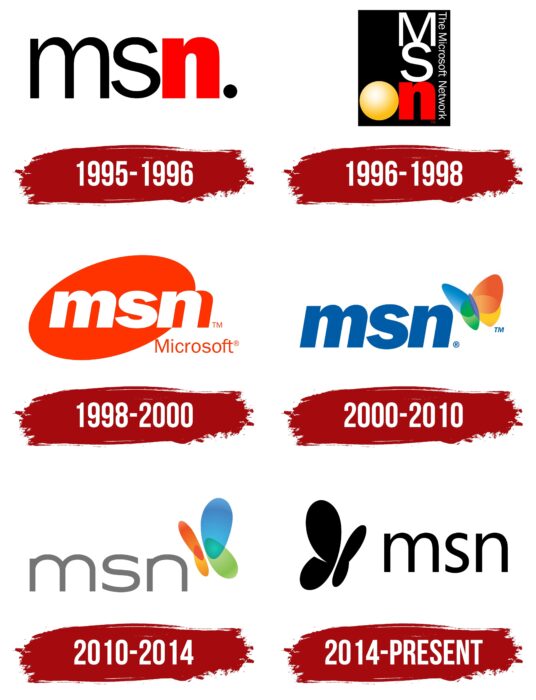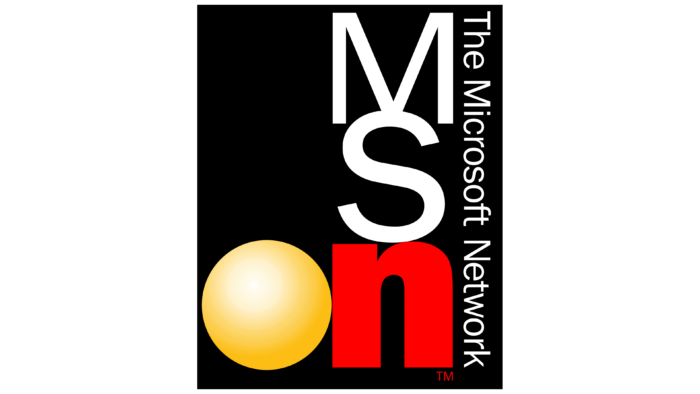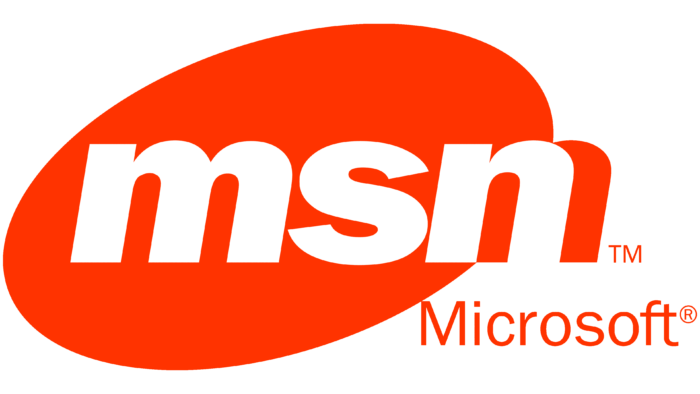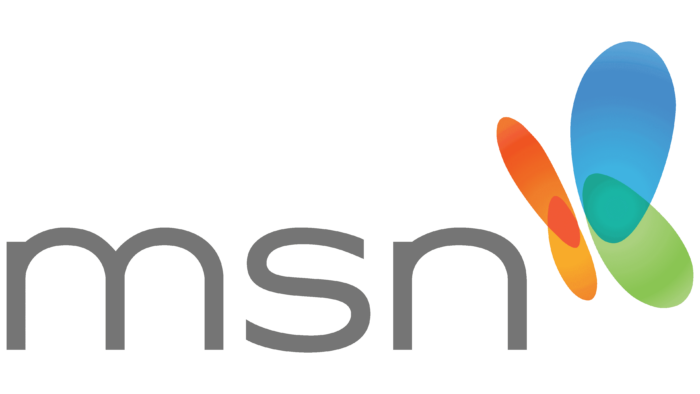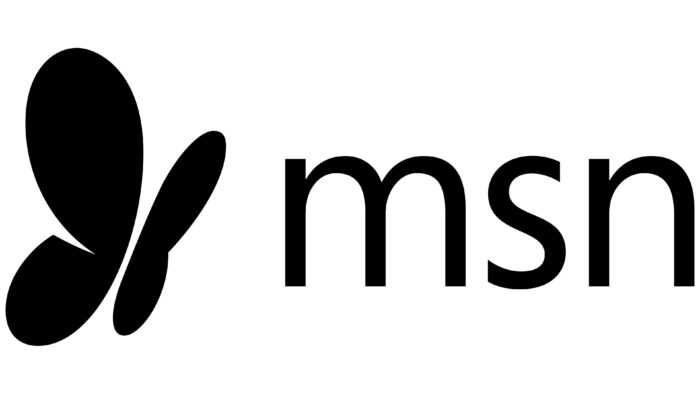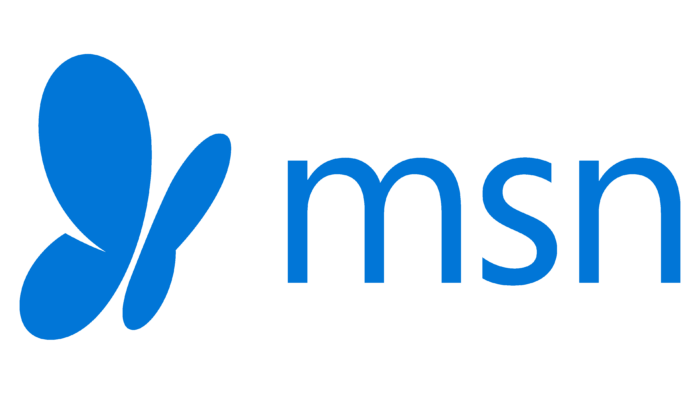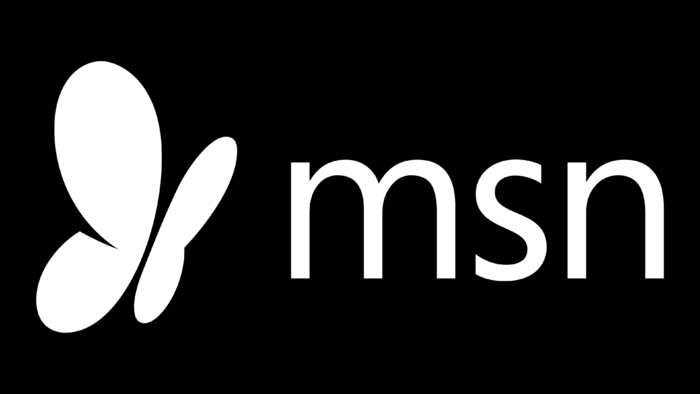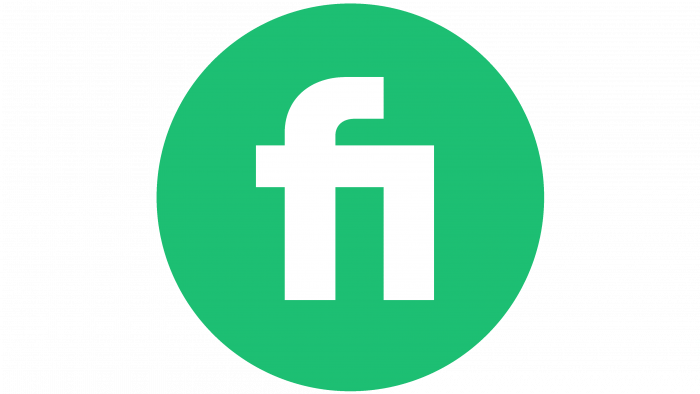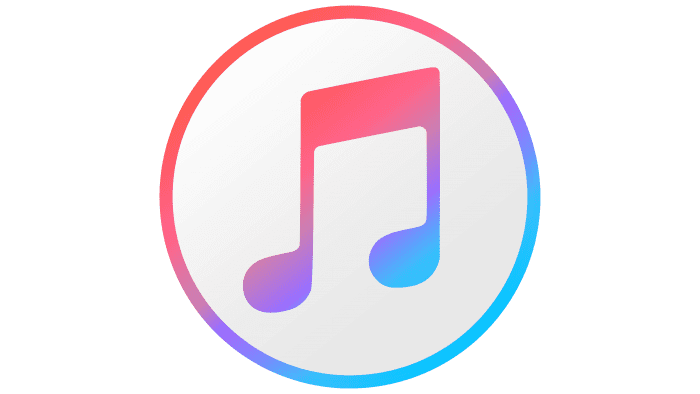The MSN logo represents the ease with which users can find online content of different categories. After all, this website contains a huge collection of Windows applications that make it easier to interact with the Internet.
MSN: Brand overview
| Founded: | August 24, 1995 |
| Founder: | Microsoft |
| Headquarters: | United States |
| Website: | msn.com |
Meaning and History
First, there was the online service Microsoft Network, which provided access to the Internet. It had its own Microsoft Internet Start portal. It acted as the start page in the Internet Explorer browser and contained useful content. In 1998, it was moved to a new domain and at the same time renamed, reducing the long two-word name to the short abbreviation MSN. The range of services united under this brand has been actively expanding. This is where the Bing search engine, the Bing Maps mapping service, and many Windows applications come from.
As stated in the branding guide, the current MSN logo contains a wordmark and a graphic image (butterfly) that cannot be separated from each other. Moreover, this is the only place where the portal’s name is written in lowercase – in all other situations, the letters must be capitalized. The copyright holder also notes that he does not oblige the use of a registered trademark mark, except in certain cases. This is not the first MSN logo: the web service has had many other identifying symbols in various configurations.
What is MSN?
MSN is a shorthand for “Microsoft Network.” This is the name of a website that hosts a collection of Windows software. There is also online content in the categories “News,” “Sports,” “Health,” “Entertainment,” “Cars,” “Travel,” “Weather,” and so on.
1995 – 1996
The debut wordmark consisted of the letters “m,” “s,” and “n” in lower case. There was a big round dot at the end of the abbreviation as if it were part of the domain name. The “n” in front of her stood out noticeably in shape and color. First, it was red, while the rest of the elements were black. Secondly, the designers made it bolder than the “m” and “s,” so the logo used two different fonts. The “m” and “s” typeface is similar to Wiescher-Design’s Franklin Gothic Raw Book, Manfred Klein’s Nonserif Regular, or Suomi Type Foundry’s TeeFranklin Medium. The lowercase “n” style is reminiscent of Sky Sans Bold by Aviation Partners, Acumin Pro Semi Condensed Black by Adobe, or Mr. Eaves XL Modern Narrow Ultra by Émigré.
1996 – 1998
After the redesign, the logo acquired a complex configuration. The base was a black vertical rectangle. Most of the space was occupied by the letters “M,” “s,” and “n,” lined up in columns one below the other, with the “M” being capitalized. In the lower left corner was a yellow ball with a gradient, which probably symbolized the global nature of the service. On the right (on the very edge) was the phrase “The Microsoft Network,” inverted so that the beginning was at the top and the end was at the bottom.
1998 – 2000
In 1998, the portal was moved to the .com domain and officially became known as MSN. Naturally, this was reflected in his logo. The designers converted the acronym to lowercase and used bold italics, roughly similar to CheapProFonts’ Familiar Pro Black Oblique. The white letters were set against an orange ellipse at about 45 degrees. Because the “n” didn’t fit entirely inside the shape, it had its orange base. The word “Microsoft” was written in a sans-serif typeface from the Segoe UI subfamily in the lower right corner.
2000 – 2010
In 2000, MSN launched a logo created by the joint efforts of McCann Erickson, FutureBrand, and Everbrand. It was launched at the beginning of the year (in February), that is, the main developments were carried out back in 1999. The designers removed the orange background and made the abbreviation dark blue. They used the grotesque Franklin Gothic Bold Italic to decorate the letters. The word “Microsoft” was removed because it interfered with the new element – a flying butterfly with multi-colored wings of green, blue, red, and yellow. The insect was in the upper right corner. Its wings were translucent so that at the points of their connection, mixed shades were obtained: green plus blue and red plus yellow. The butterfly seemed voluminous due to the gradient and light highlights, and it also cast a light gray shadow.
2010 – 2014
A decade later, MSN decided on another redesign, which was recognized as one of the worst (according to Brand New). The portal started implementing the new logo on December 29, 2009, and completed the process in March 2010, although the website was originally scheduled to be redesigned in autumn 2009. As a result of the changes, the butterfly has become much simpler. Both wings on the left side were scaled down and repainted orange with a gradient, while blue and green were used for the right side. The difference in size was supposed to reflect the tilted flight of the butterfly.
The designers changed the font, making the letters straight, thin, and light gray. It was similar to Artegra Sans Extended Regular by Artegra or Chinger Regular by Bud White, with the tops of the vertical strokes at “m” and “n” cut off.
2014 – today
In October 2014, a redesigned version of the MSN badge was introduced, with the butterfly turned black and moved to the top left corner. At the same time, the shape of her wings slightly changed: one of them had a sharp corner. The inscription, like the butterfly, is now also black, so there is a complete harmony of colors in the composition. For letters, a font from the Segoe UI subfamily is used. The word “Microsoft” was written in almost the same humanistic grotesque as part of the 1998-2000 logo.
Font and Colors
The butterfly is MSN’s signature symbol, but how does it relate to the website’s history? This is likely just a beautiful element that symbolizes beauty, rebirth, and immortality. In Native American culture, she represents positive change, joy, beauty, and transformation. There is no hidden connection with the functions or heritage of the web portal here. The butterfly was originally a joint fantasy between McCann Erickson, FutureBrand, and Everbrand. This image was so memorable and represented MSN so vividly that it was decided to keep it in all subsequent versions of the emblem. By the way, the Illuminati has one little-known symbol – the monarch butterfly. It represents mind control.
The current MSN logo is set in the humanistic grotesque Segoe UI. It belongs to a family of fonts created by typographer Steve Mattson in 1994, specifically for Microsoft. This typeface is used in all products of the American company for a uniform display of text. Remarkably, in the MSN wordmark, all letters are lowercase, while in other cases, they must be uppercase. Previously, the abbreviation was painted in the corporate color of the portal – blue Pantone 3005. After the redesign, both the butterfly and the brand name became black.
MSN color codes
| Black | Hex color: | #000000 |
|---|---|---|
| RGB: | 0 0 0 | |
| CMYK: | 0 0 0 100 | |
| Pantone: | PMS Process Black C |

